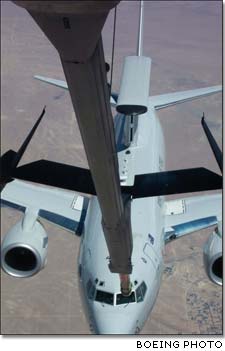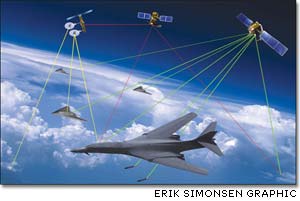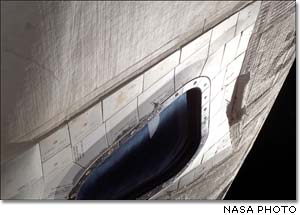|  First grades First grades
Boeing
Integrated Defense Systems initiated Business Excellence just over a
year ago to promote continuous improvement and improve results. The year
included internal assessments to determine what's working well and what
isn't.
Boeing Frontiers spoke to Debbie Collard, Business Excellence
director, to get an update on BE efforts.
FULL STORY >>

Eagle's nest
 The Australian Department of Defence begins its official summary of
Project Wedgetail with a description of the wedgetail eagle, a native
bird of prey. The eagle is known for its acute vision, wide range, ability
to remain airborne for long periods, and uncompromising instinct to defend
its territory. Not to mention that with its sharp talons and beak, 7.5-foot
(2.3-meter) wingspan, and history of attacking helicopters and small
airplanes, this predator is one intimidating beast. The Australian Department of Defence begins its official summary of
Project Wedgetail with a description of the wedgetail eagle, a native
bird of prey. The eagle is known for its acute vision, wide range, ability
to remain airborne for long periods, and uncompromising instinct to defend
its territory. Not to mention that with its sharp talons and beak, 7.5-foot
(2.3-meter) wingspan, and history of attacking helicopters and small
airplanes, this predator is one intimidating beast.
For these reasons, Wedgetail is the name given to Australia's program
to acquire Airborne Early Warning and Control (AEW&C) surveillance
capability. With Boeing as the prime contractor and the 737-700 as the
platform, most of the modification work to date has been located in Seattle.
A modified Wedgetail aircraft rolled out of the Boeing Field facility
in March 2004 and another in August 2005; both are in flight test in the
United States. They are scheduled for delivery to Royal Australian Air
Force (RAAF) Base Williamtown, New South Wales, in the fourth quarter
of 2006.
FULL STORY >>

Capability through connections
 As a U.S. Air Force officer during Operation
Desert Storm, George Muellner commanded the Joint Surveillance Target
Attack System unit that flew every night of the war. The E-8 (707-300)
Joint STARS aircraft were equipped with mission systems that provided
both air and ground commanders with wide-area surveillance and downlink
of targeting information. As a U.S. Air Force officer during Operation
Desert Storm, George Muellner commanded the Joint Surveillance Target
Attack System unit that flew every night of the war. The E-8 (707-300)
Joint STARS aircraft were equipped with mission systems that provided
both air and ground commanders with wide-area surveillance and downlink
of targeting information.
Although Joint STARS proved to be the most decisive intelligence asset
of the war, its effectiveness was reduced by the inability to get its
information to the decision maker or the warfighter rapidly.
"Good intelligence that does not enable rapid and decisive decision
making is of little value," said Muellner, now vice president and
general manager of Air Force Systems for Boeing Integrated Defense Systems.
FULL STORY >>

Analyze this
 Performing a first-of-its-kind repair is a
challenge in itself. But try assessing the need for repairs and developing
repair techniques while the vehicle in question circles the earth at
17,500 mph (28,200 kilometers per hour) and an altitude of 225 miles
(362 kilometers). Performing a first-of-its-kind repair is a
challenge in itself. But try assessing the need for repairs and developing
repair techniques while the vehicle in question circles the earth at
17,500 mph (28,200 kilometers per hour) and an altitude of 225 miles
(362 kilometers).
Boeing played a critical role in doing just that by helping NASA resolve
several on-orbit anomalies during the most recent Space Shuttle mission,
STS-114.
Boeing engineers fill console positions in the NASA Mission Evaluation
Room at Johnson Space Center in Houston. The MER team, which includes
representatives from NASA and industry, including Boeing, examines all
data during a flight and makes recommendations on corrective actions
for any observed problems.
Following a review of camera imagery from inspection of the Orbiter
Thermal Protection System (TPS) with the Orbiter Boom Sensor System,
engineers spotted two protruding "gap fillers" between tiles
on Space Shuttle Discovery's belly.
FULL STORY >>
|

